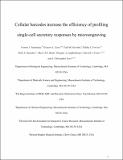Cellular Barcodes for Efficiently Profiling Single-Cell Secretory Responses by Microengraving
Author(s)
Gierahn, Todd Michael; Forcier, Talitha L.; Brefo, Mavis S.; Yamanaka, Yvonne J.; Szeto, Gregory; Arnold, Kelly B.; Lauffenburger, Douglas A; Irvine, Darrell J; Love, John C; ... Show more Show less
DownloadLove_Cellular barcodes.pdf (4.255Mb)
PUBLISHER_POLICY
Publisher Policy
Article is made available in accordance with the publisher's policy and may be subject to US copyright law. Please refer to the publisher's site for terms of use.
Terms of use
Metadata
Show full item recordAbstract
We present a method that uses fluorescent cellular barcodes to increase the number of unique samples that can be analyzed simultaneously by microengraving, a nanowell array-based technique for quantifying the secretory responses of thousands of single cells in parallel. Using n different fluorescent dyes to generate 2n unique cellular barcodes, we achieved a 2n-fold reduction in the number of arrays and quantity of reagents required per sample. The utility of this approach was demonstrated in three applications of interest in clinical and experimental immunology. Using barcoded human peripheral blood mononuclear cells and T cells, we constructed dose–response curves, profiled the secretory behavior of cells treated with mechanistically distinct stimuli, and tracked the secretory behaviors of different lineages of CD4+ T helper cells. In addition to increasing the number of samples analyzed by generating secretory profiles of single cells from multiple populations in a time- and reagent-efficient manner, we expect that cellular barcoding in combination with microengraving will facilitate unique experimental opportunities for quantitatively analyzing interactions among heterogeneous cells isolated in small groups (2–5 cells).
Date issued
2012-12Department
Massachusetts Institute of Technology. Department of Biological Engineering; Massachusetts Institute of Technology. Department of Chemical Engineering; Massachusetts Institute of Technology. Department of Materials Science and Engineering; Ragon Institute of MGH, MIT and Harvard; Koch Institute for Integrative Cancer Research at MITJournal
Analytical Chemistry
Publisher
American Chemical Society
Citation
Yamanaka, Yvonne J., Gregory L. Szeto, Todd M. Gierahn, et al. 2012 Cellular Barcodes for Efficiently Profiling Single-Cell Secretory Responses by Microengraving. Analytical Chemistry 84(24): 10531–10536.
Version: Author's final manuscript
ISSN
0003-2700
1520-6882